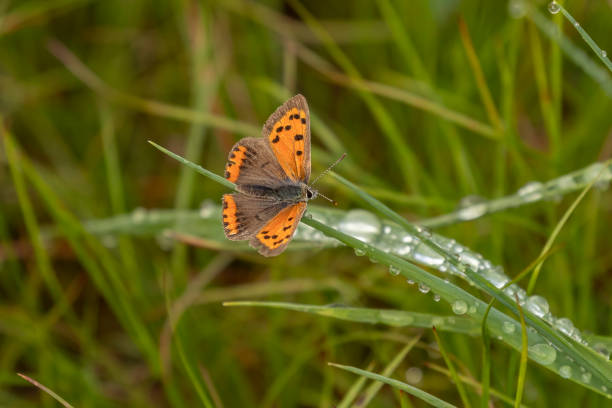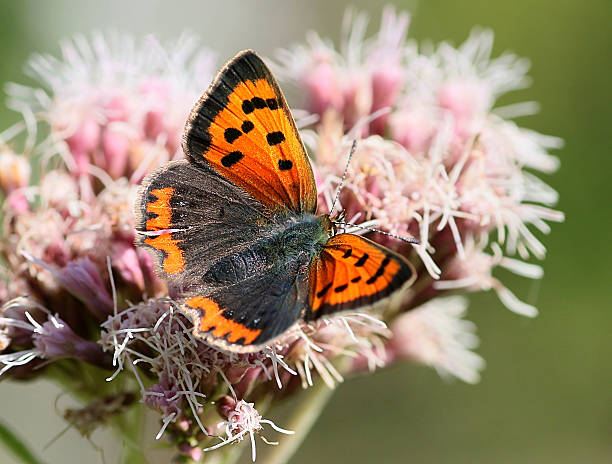Table of Contents
Scientific Classification
| Kingdom | Animalia |
| Phylum | Arthropoda |
| Class | Insecta |
| Order | Lepidoptera |
| Family | Lycaenidae |
| Genus | Lycaena |
| Species | Lycaena phlaeas. |
| Scientific Name | Lycaena phlaeas |
Description
The American Copper Butterfly (Lycaena phlaeas) is a small yet eye-catching butterfly that belongs to the Lycaenidae family. It has a wingspan that ranges from 22 to 35 millimeters. The forewings are a vibrant orange adorned with black spots, while the hindwings are a rich brown with an orange border. The underside of the wings features a muted grayish-brown color with small dark spots, providing effective camouflage.
Males and females look quite similar, although females are generally a bit larger. This butterfly is known for its quick, darting flight patterns, which can make it challenging to catch or observe closely.
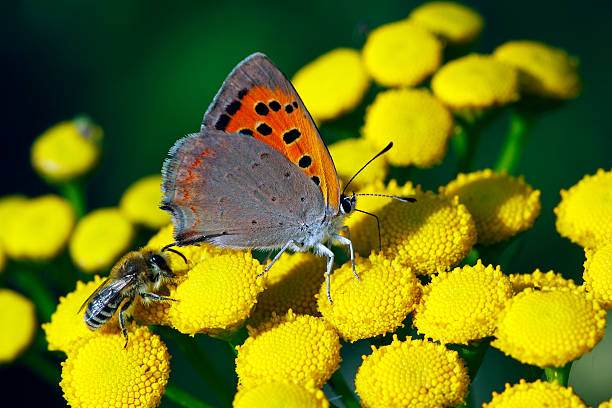
Distribution
The American Copper Butterfly is found throughout North America, including both the US and Canada, and it also inhabits certain areas of Europe and Asia. This wide distribution makes it one of the most adaptable butterfly species in terms of geography.
This butterfly prefers temperate regions and can flourish in a variety of climates, such as coastal plains and mountainous areas. The American Copper Butterfly thrives particularly well in locations where its host plants are abundant, especially dock plants from the Rumex genus.
Habitat
The American Copper Butterfly prefers open spaces with plenty of sunlight. Common habitats include:
Meadows
Grasslands
Roadsides
Parks and gardens
Marsh edges
These butterflies are usually near their host plants. They depend on these plants for reproduction and food in their early stages.
Diet
Larvae:
Caterpillars primarily feed on plants from the Rumex (dock) and Polygonum (knotweed) families. These plants supply the essential nutrients needed for their growth and development.
Adults:
Adult butterflies feed on nectar from various flowering plants. Their favorite nectar sources include:
Buttercups
Dandelions
Clover
Milkweed
Asters
The American Copper is a generalist feeder. This means it can survive in many different environments.
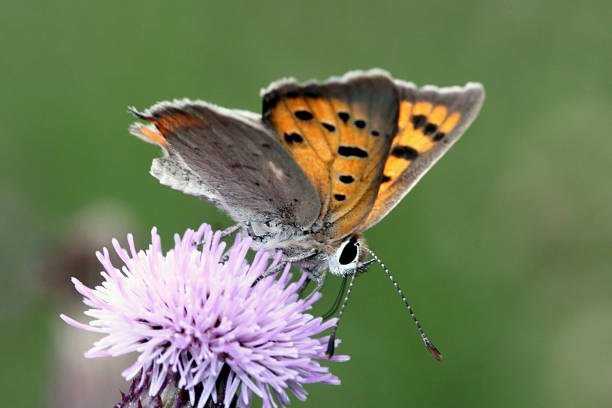
Behavior
American Copper Butterflies are very territorial creatures. Males establish small territories where they chase off other males and attempt to attract females. Their flight is quick and erratic, which makes them hard to track.
These butterflies are diurnal, meaning they are active during the day. They tend to thrive in warm, sunny conditions and are often seen basking with their wings fully open to absorb the heat.
Lifespan
The lifespan of an American Copper Butterfly can vary based on environmental factors. Typically:
The adult butterfly has a lifespan of around 2 to 3 weeks.
The complete lifecycle, from egg to adult, spans approximately 5 to 7 weeks.
In warmer regions, multiple generations may emerge within a single year, while in colder climates, only one or two broods are likely to be observed.
Reproduction and Lifecycle
The reproductive cycle of the American Copper Butterfly follows a typical butterfly pattern:
Egg Stage:
Females lay small, pale green eggs on the underside of host plant leaves.
The eggs hatch within a week or two, depending on temperature and humidity.
Larval Stage:
The caterpillar emerges and begins feeding immediately.
It undergoes several molts before pupating.
Caterpillars are green with fine hairs, blending well with leaves.
Pupal Stage:
The pupal stage, or chrysalis, lasts about 10 to 15 days.
The chrysalis is attached to the plant, where it undergoes metamorphosis.
Adult Stage:
After emerging, the adult butterfly quickly seeks mates to begin the next cycle.
Depending on the climate, the American Copper Butterfly can have two to three broods per year.
Predators
American Copper Butterflies, though small, face a variety of natural predators, such as:
Birds – Especially insect-eating species like warblers and swallows.
Spiders – Certain web-building types ensnare butterflies in their silk traps.
Praying Mantises – These ambush hunters capture unsuspecting butterflies.
Dragonflies – Renowned for catching butterflies in flight.
Ants and Wasps – Focus on the eggs and larvae.
To evade these threats, American Copper Butterflies are quick fliers and adept at blending into their surroundings.
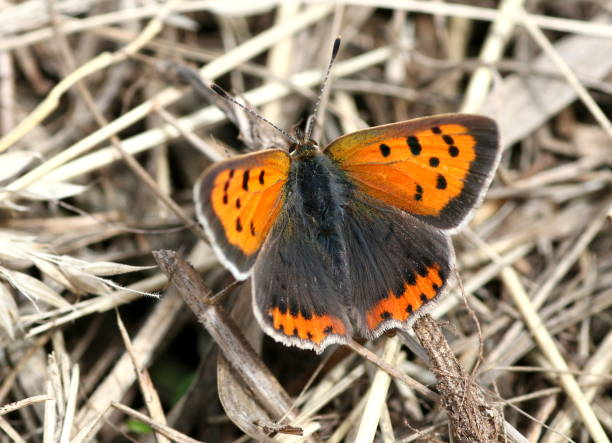
Adaptations
The American Copper Butterfly has developed several adaptations to thrive in different environments:
Camouflage:
Its brownish wings resemble dried leaves, allowing the butterfly to blend in and remain hidden while resting.
Rapid Flight:
The butterfly’s fast and erratic flight patterns help it escape from predators.
Territorial Behavior:
Males actively defend their territories, which boosts their chances of mating and reduces competition.
Multiple Broods:
The ability to have more than one generation per year ensures species continuity even if some individuals fall prey to predators.
Conservation Status
At present, the American Copper Butterfly is not classified as endangered. It is categorized as a species of Least Concern due to its broad distribution and adaptability.
Threats:
Habitat destruction: Urban development and agricultural activities can diminish available breeding sites.
Pesticides: The use of insecticides in farming can adversely affect both caterpillars and adult butterflies.
Climate change: Severe weather patterns may interfere with breeding cycles and the availability of food.
Conservation Efforts:
Conservationists promote the planting of nectar-rich flowers and host plants in gardens and parks.
Reducing pesticide use can help safeguard butterfly populations.
Certain protected areas and wildlife reserves are working to preserve habitats that are friendly to butterflies.
Conclusion
The American Copper Butterfly is a remarkable and resilient species. With its vibrant appearance, it can thrive in various environments. Protecting its habitat and regulating pesticide use are crucial for its survival. Although it is not currently endangered, these measures help keep the species safe in the wild. Observing these small, colorful butterflies in their natural habitat is truly delightful, offering a glimpse into the rich diversity of our ecosystems.
